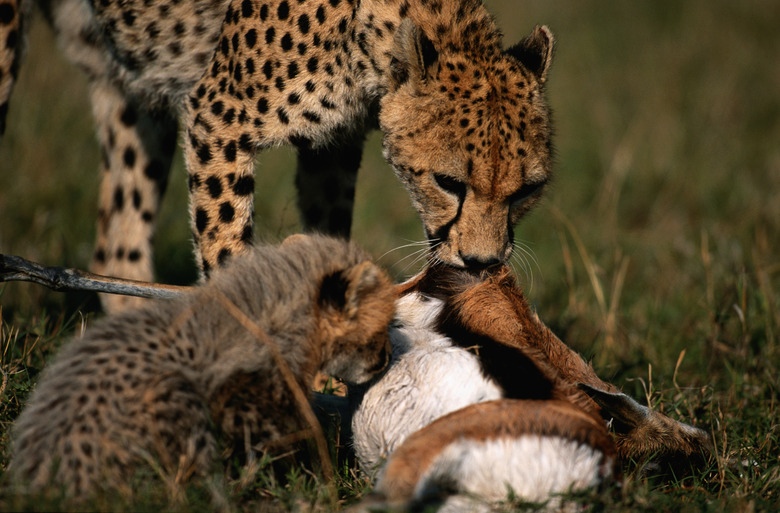5 Central Themes Of Biology
From amoebas to baboons, all living things have a few things in common. Five central themes of biology set the living apart from the inanimate. Take viruses: They seem to be alive, but many biologists don't consider them so since they lack one or more of these unifying characteristics. Here are the factors that help distinguish the living from the not-so-living.
TL;DR (Too Long; Didn't Read)
The five central themes of biology are **structure and function of cells**, **interactions between organisms**, **homeostasis**, **reproduction and genetics**, and **evolution**.
Structure and Function of Cells
Structure and Function of Cells
All life-forms consist of at least one cell. In the 17th century, scientists Robert Hooke and Anton von Leeuwenhoek observed cells and noted their characteristics under microscopes. These and subsequent observations led to the formation of the cell theory, stating that cells make up all life, carry out all biological processes and can only come from other cells. All cells contain genetic material and other structures floating in a jelly-like matrix, acquire energy from their surroundings, and are enveloped in protection from the external environment.
Interactions Between Organisms
Interactions Between Organisms
Organisms don't exist in vacuums. Each living thing has uniquely adapted to a particular habitat and developed specific relationships with other organisms in the same area.
In ecosystems, plants use light energy from the sun to make their own food, which becomes a source of energy for other organisms that consume the plants. Other creatures eat these plant-eating organisms and receive the energy. When plants and animals die, their energy flow doesn't stop; instead, the energy transfers to the soil and back into the environment, thanks to scavengers and decomposers that break down dead organisms.
There are various connections between life-forms. Predators eat prey, parasites find nutrients and shelter at the expense of others, and some organisms form mutually beneficial relationships with one another. As a result, changes affecting one species influence the survival of others within the ecosystem.
Homeostasis Keeps Living Things Alive
Homeostasis Keeps Living Things Alive
In multicellular creatures, all organ systems work together to balance substances such as:
- fluids
- ions
- acidity
- gases
- wastes
Each species can tolerate only specific environmental conditions within its range of tolerance. Outside of this range lies the zone of intolerance where all members of a species die. When the external environment changes, individuals have to maintain a constant internal environment through constant adaptation. Otherwise, they perish.
Reproduction and Genetics
Reproduction and Genetics
All organisms reproduce and pass on characteristics to their offspring. In asexual reproduction, offspring are exact replicas of their parents. More complex life-forms lean toward sexual reproduction, which involves two individuals producing offspring together. In this case, the offspring show characteristics of each parent.
In the mid 1800s, an Austrian monk named Gregor Mendel conducted a series of famous experiments exploring the relationship between sexual reproduction and heredity. Mendel realized that units called genes determined heredity and could be passed from parent to offspring.
Evolution and Natural Selection
Evolution and Natural Selection
In the early 1800s, French biologist Jean Baptiste de Lamarck hypothesized that the use of certain features would strengthen their existence, and nonuse would cause them to eventually disappear in subsequent generations. This would explain how snakes evolved from lizards when their legs weren't being used, and how giraffe necks grew longer with stretching, according to Lamarck.
Charles Darwin constructed his own theory of evolution called natural selection. Following his stint as a naturalist on the ship HMS Beagle, Darwin formulated a theory that claimed all individuals possess differences that allow them to survive in a particular environment, reproduce, and pass on their genes to their descendants. Individuals that adapt poorly to their environments would have fewer opportunities to mate and pass on their genes. Eventually, the genes of the stronger individuals would become more prominent in subsequent populations. Darwin's theory has become the most accepted theory for evolution.
Cite This Article
MLA
Dinh, Ho-Diep. "5 Central Themes Of Biology" sciencing.com, https://www.sciencing.com/5-central-themes-biology-12060594/. 24 April 2018.
APA
Dinh, Ho-Diep. (2018, April 24). 5 Central Themes Of Biology. sciencing.com. Retrieved from https://www.sciencing.com/5-central-themes-biology-12060594/
Chicago
Dinh, Ho-Diep. 5 Central Themes Of Biology last modified August 30, 2022. https://www.sciencing.com/5-central-themes-biology-12060594/
